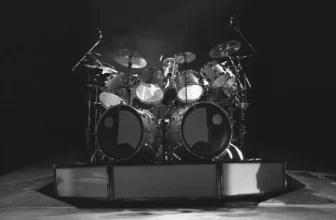The Nashville Number System for Drummers Explained


By Sidney Joseph
The Nashville Number System (NNS for short), is a shorthand method of writing out a song’s chord structure. It enables musicians to play and record together quickly, and with little other communication about a song’s arrangement needed.
The understanding of chord structures, musicality, and song form is ABSOLUTELY VITAL for all musicians. It’s especially true for drummers since we are the very backbone of both the band and the song.
Music Theory Basics
To recognize what the numbers and symbols mean on a chart, we will first have to have some basic understanding of music theory.
In any major or minor key (a collection of notes that sound good together), seven notes make up the scale for that key.
The numbers (1 to 7) are representative of the notes of the scale, in ascending order. In C Major, those scale degrees would be as follows:
- C
- D
- E
- F
- G
- A
- B
The scale then repeats again from the first degree (C). While there isn’t space in this article to explain why it is so, there is something fundamental to understand at this stage.
In a major key, the 1, 4, and 5 chords are all major, while the 2, 3, and 6 are all minor, and the 7 chord is diminished.
NNS Practical Example
Let’s say, for example, you were given a Nashville number chart, where the first line read as follows:
1 6 4 5
In the key of C Major, the chords that relate to those numbers are C, A, F, and G, respectively.
As we know from above, chords 1, 4, and 5 are all major, but chord 6 is minor. So the chords would be C major (1), A minor (6), F major (4), and G major (5). The band would then play those chords for the first section of that song.
How long each chord is held for, whether a full bar or half bar, is determined by the spacing of the chords on the written chart. Various symbols are also used, either to explain a performance mechanic or to identify a particular chord further.

An example would be using a dash, which denotes a minor chord, such as “6-” for 6 minor.
There are also staccato, or shortened notes “^,” and pushed or delayed notes “< or >.” A diamond shape drawn around a chord number means that the chord should ring out for a full bar.
The beauty of the NNS is that if you are in the studio recording a song, and the artist needs to change the key, you don’t have to write out a new chart.
The band would simply apply the scale degree numbers on the chart, to the new key. If the musicians are technically proficient, which most session players are, the band should be able to play it almost right away in the new key.
The same goes for a key change section within a song, often called a modulation (or “MOD” for short)—the numbers just apply to the new key.
History Of The NNS
The Nashville Number System is not a system that utilizes entirely new information, but rather is a method of organizing our current understanding of music theory.
Numbered scale degrees have been around since the 18th Century, where Roman numerals were used to represent chords.
However, the reason that the NNS is so brilliant is that it is both sophisticated and straightforward. It allows musicians of all different backgrounds to be able to play together easily, and saves time in both writing out and reading charts.
Formally trained musicians understand the numbered scale degrees, as do many self-taught musicians, even if they cannot read fully-notated music.
The NNS was first developed in the 1950s by Neal Matthews Jr. He used scale numbers to communicate vocal parts with his group, the Jordanaires, as well as numbers for chords to show the session musicians which chords to play.
The Jordanaires worked as backup and session vocalists for such well-known artists as Elvis Presley, Patsy Cline, Cliff Richard, Dolly Parton, Johnny Cash, and Don McLean.

They would often do 3-4 different recording sessions a day, and so had to be able to quickly learn, remember, and perform a high volume of songs. Matthews’ idea was then further developed by the famous Nashville multi-instrumentalist Charlie McCoy.
McCoy is known for working with such artists as Bob Dylan, Elvis Presley, Johnny Cash, Paul Simon, and Joan Baez, among many others. This system is now a staple in Nashville recording sessions. It allows the sessions to happen with great ease and efficiency.
NNS For Drummers
As drummers, we should first seek to understand how chords and melody work within a song. This knowledge and understanding allows us to be involved with the musicality of the song we are playing and elevates us from merely counting the number of bars in a section.
Thinking about how the chords follow on from each other, as well as how they are structured in a song, leads us to make more musical decisions.
We also conceive of the music, and our drum parts, from a more natural place. We start to “hear” where the chord changes happen.
Of course, we should always care deeply about what groove we play in a song, and which fill we choose to play.
But we should not only obsess about our own part. We ought to hear and approach each and every song MUSICALLY—from a melodic and harmonic perspective.
This, along with lyrics, is where much of the emotional content of a song lies. Many of us do this intuitively, but having the knowledge to go along with that intuition, is an absolute killer combination in the music business.
Understanding the Nashville Number System, or even knowing basic music theory and chord numbers, is one of the most overlooked, yet powerful tools that any drummer can have.
Let us remember, we will almost never get booked for a gig by another drummer. So no matter how impressive our chops are to other drummers, the guitarists, keyboard players, bassists and singers are going to be the ones calling us for gigs.
This is not to say that chops are bad, but rather, that we should develop our musical chops, just as much as we build our 32nd note fills. Let’s always strive to be the most musical drummers that we can possibly be.

About the Author
Sidney Joseph is an international session drummer who has worked and performed with Gungor, Lacey Sturm, Dave Weckl, and Richie Gajate-Garcia, among many others.






Hi Sidney! Ron Turner here in Auburn Washington. I think this is the very best explanation of the concept and application of the NNS I’ve ever heard.
Thought you would like to know. When a drummer can understand and apply something as clarifying as this, it can literally be a complete game changer. Thank you so much!
My Very Best,
Ron